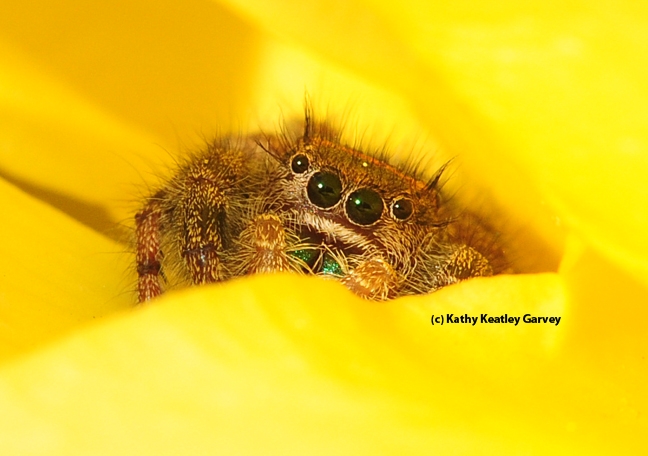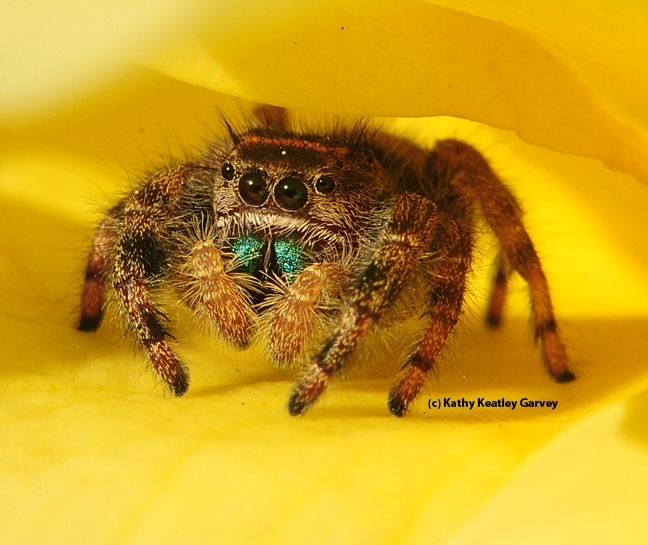
Ophthalmologist and professor Ivan Schwab of the UC Davis Health System says that spiders “get a bad rap. Few would harm you, and only rarely are spiders aggressive towards humans. Most will defend themselves if threatened, of course, and a few are venomous. Most spiders, however, would prefer to ignore humans and be ignored by us.”
At his UC Davis Department of Entomology and Nematology seminar on Oct. 23 in Briggs Hall, Dr. Schwab told the crowd that jumping spiders have the “best acuity of all spiders.” They are ambush spiders, lying in wait for prey.
If you visit your garden or a neighborhood park, you may see a jumping spider looking back at you. Last Sunday we spotted a jumping spider lurking beneath the petals of a yellow rose. Meanwhile, a honey bee foraged above it.
That reminded us of what Dr. Schwab said about spiders and how they see.
Background: Dr. Schwab directs the Cornea and External Disease Service and serves as the medical advisor of the eye bank, as well as professor of ophthalmology in the Department of Ophthalmology and Vision Science. He’s the author of five books, including the highly acclaimed Evolution’s Witness: How Eyes Evolved, published in November 2011. He describes the eye as "evolution's greatest gift and its greatest triumph."
The UC Davis ophthalmologist writes an informative blog, Evolution’s Witness, and recently penned one, with amazing detail, on jumping spiders. “Jumping spiders are positively charming creatures, and you will know that to be true if you have ever watched one closely. These are common spiders and range from approximately 3 to 17 mm in length and will watch you closely as you approach them. They have four pairs of eyes, with the large anterior median (AM) set the most obvious. These circular eyes provide an ‘attentive child’ appearance because they are fixed and are relatively large based on body size, but are tiny on an absolute scale. These placid eyes belie the organized complexity and evolutionary genius that lies beneath the carapace.”
Dr. Schwab goes on to describe the AM eyes as "Galilean telescopes with a corneal lens fixed to the carapace, and a second 'lens' at the end of a small tube immediately in front of the retina."
"This compact telephoto lens system combined with the tiered retina," he says, "achieves excellent acuity, but only a very tiny field of vision. So, to increase this field of acute vision, this optical marvel moves the tube housing the retina with six muscles per eye by mostly scanning movements. This is akin to a raster scan similar to those seen on a TV or computer screen. Jumping spiders scan their world much like painting a wall with a fine brush although the retina is not linear, but shaped more like a boomerang. The other pairs of eyes do not scan and are principally used as motion detectors to find other animals for the AM eyes to decipher."
"With the AM eyes, jumping spiders have the finest discrimination of all arthropods, and probably all invertebrates as they are visual hunters, whereas most other spiders use the tools of silk."
Dr. Schwab marvels at how a jumping spider is able to see so well and ambush its prey. "If the spider moves, it may frighten the prey, so the spider needs another mechanism." Read Dr. Schwab's column for the details on that mechanism. After you do, you'll come away with a greater appreciation of jumping spiders and that most amazing organ, the eye.
By the way, this visual hunter (below) didn't nab the honey bee Sunday afternoon....but it may have later.
Attached Images:

Jumping spider peering between the petals of a yellow rose. (Photo by Kathy Keatley Garvey)

Close-up of jumping spider as it emerges from its hiding place. (Photo by Kathy Keatley Garvey)

Side view of jumping spider. (Photo by Kathy Keatley Garvey)

The prey (honey bee) that the predator (jumping spider) was seeking. (Photo by Kathy Keatley Garvey)